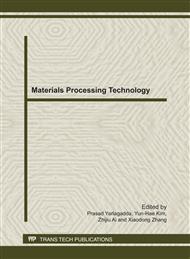p.368
p.372
p.379
p.383
p.387
p.392
p.396
p.402
p.406
Influence of Cutting Conditions on the Cutting Performance of TiAl6V4
Abstract:
The FEM simulation was developed to investigate the influences of cutting speed, uncut chip thickness and tool rake angle on the cutting performance of TiAl6V4. The FEM simulation was validated using experimental results and good agreement was obtained. The simulation results indicate that the transition from continuous to saw-tooth chip formation is favored by increases in cutting speed and uncut chip thickness and a decrease in tool rake angle. The existence of Salomon’s assumption was further discussed, which shows that the Salomon’s assumption is not valid for the tool-chip interface temperature, but could be true for the surface temperature of the workpiece. In addition, decreasing the uncut chip thickness leads to an increase of the specific cutting energy, which could be primarily caused by an increase in the shear strength of the workpiece material due to a decrease in the PSZ temperature.
Info:
Periodical:
Pages:
387-391
Citation:
Online since:
September 2011
Authors:
Keywords:
Price:
Сopyright:
© 2011 Trans Tech Publications Ltd. All Rights Reserved
Share:
Citation:


